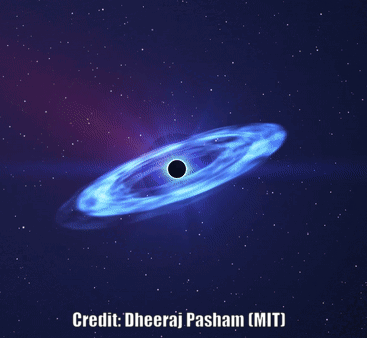Detected a jet of particles as bright as 1,000 trillion Suns coming from a black hole

Its high brightness could be due to the fact that, among other reasons, the beam of matter points directly towards the Earth
The observations could illuminate how supermassive black holes feed and grow
An international team led by researchers at NASA, Caltech and elsewhere, posted early this year the discovery of the extraordinary flash detected in a part of the sky with the optical telescope Zwicky Transient Facility (ZTF), based at the Palomar Observatory (California). From a rough calculation, the flash appeared to give off more light than 1,000 trillion Suns.
The signal drew the attention of astronomers around the world and over the next few days multiple telescopes focused on the signal to gather more data across multiple wavelengths (to X-ray, ultraviolet, optical, and radio bands).
Recently, a team of researchers of the Massachusetts Institute of Technology (MIT) and of the Institute of Space Studies in Catalonia (IEEC) at the Institute of Space Sciences (ICE-CSIC), along with other collaborators, have determined a likely source for the signal. The study is appearing today in the Nature Astronomy journal.
The signal, named AT 2022cmc, is likely from a relativistic jet of matter, streaking out from a supermassive black hole at close to the speed of light. The astronomers believe the black hole suddenly began devouring a nearby star, releasing a huge amount of energy in the process.
Credits: Dheeraj Reddy (MIT), Tomás E. Müller Bravo (ICE-CSIC, IEEC), Noel Castro Segura (University of Southampton), and others.
The authors of the study have observed other such “tidal disruption events” (TDE) in which a passing star is torn apart by a black hole's tidal forces. The signal AT 2022cmc is brighter than any TDE discovered to date and is also the farthest TDE ever detected, at some 8.5 billion light years away—more than half the age estimated of the universe.
The postdoctoral researchers from the ICE-CSIC and IEEC’s members Tomás E. Müller Bravo and Lluís Galbany participate in this study, along with MIT authors Matteo Lucchini, Dheeraj “DJ” Pasham, Peter Kosec, Erin Kara and Ronald Remillard, and other collaborators from universities and institutions around the world.
The team says the black hole's jet may be pointing directly toward Earth, making the signal appear brighter than if the jet were pointing in any other direction. The effect is known as “Doppler boosting” and is similar to the amped-up sound of a passing siren.
The signal of this study is the fourth Doppler-boosted TDE ever detected and the first such event that has been observed since 2011. It is also the first TDE discovered using an optical sky survey.
“Constant monitoring of the sky is essential to detect this type of event as early as possible and later do extensive monitoring with multiple telescopes,” noted the researcher Tomás E. Miller (ICE-CSIC, IEEC).
As more powerful telescopes start up in the coming years, they will reveal more TDEs, which can shed light on how supermassive black holes grow and shape the galaxies around them.
“The discovery of this very distant TDE shows that we can find more in the future at these distances with the LSST (Legacy Survey of Space and Time) project of the Vera C. Rubin Observatory, an 8-metre telescope that is being built in Chile and that will start taking data at the end of 2024”, adds the researcher Lluís Galbany (ICE-CSIC, IEEC).
Press release prepared in collaboration with the Communication Office of the Massachusetts Institute of Technology (MIT) and the Institute of Space Sciences (ICE-CSIC).
Main Image
Credits: Dheeraj Pasham/ MIT.
Links
More information
This research is presented in a paper entitled “The Birth of a Relativistic Jet Following the Disruption of a Star by a Cosmological Black Hole” by Pasham, D.; Lucchini, M.; et al., appeared in the journal Nature Astronomy on 30 November 2022.
The Institute of Space Studies of Catalonia (IEEC — Institut d’Estudis Espacials de Catalunya) promotes and coordinates space research and technology development in Catalonia for the benefit of society. IEEC fosters collaborations both locally and worldwide and is an efficient agent of knowledge, innovation and technology transfer. As a result of 25 years of high-quality research, done in collaboration with major international organisations, IEEC ranks among the best international research centers, focusing on areas such as: astrophysics, cosmology, planetary science, and Earth Observation. IEEC’s engineering division develops instrumentation for ground- and space-based projects, and has extensive experience in working with private or public organisations from the aerospace and other innovation sectors.
IEEC is a private non-profit foundation, governed by a Board of Trustees composed of Generalitat de Catalunya and four other institutions that each have a research unit, which together constitute the core of IEEC R&D activity: the Universitat de Barcelona (UB) with the research unit ICCUB — Institute of Cosmos Sciences; the Universitat Autònoma de Barcelona (UAB) with the research unit CERES — Center of Space Studies and Research; the Universitat Politècnica de Catalunya · BarcelonaTech (UPC) with the research unit CTE — Research Group in Space Sciences and Technologies; the Spanish Research Council (CSIC) with the research unit ICE — Institute of Space Sciences. The IEEC is a CERCA (Centres de Recerca de Catalunya) center.
Contacts
IEEC Communication Office
Barcelona, Spain
E-mail: comunicacio@ieec.cat
Lead Researcher at IEEC
Barcelona, Spain
Lluís Galbany
Institute of Space Studies of Catalonia (IEEC)
Institute of Space Sciences (ICE-CSIC)
E-mail: lgalbany@ieec.cat, lgalbany@ice.csic.es
Tomás E. Müller Bravo
Institute of Space Studies of Catalonia (IEEC)
Institute of Space Sciences (ICE-CSIC)
E-mail: muller@ice.csic.es
